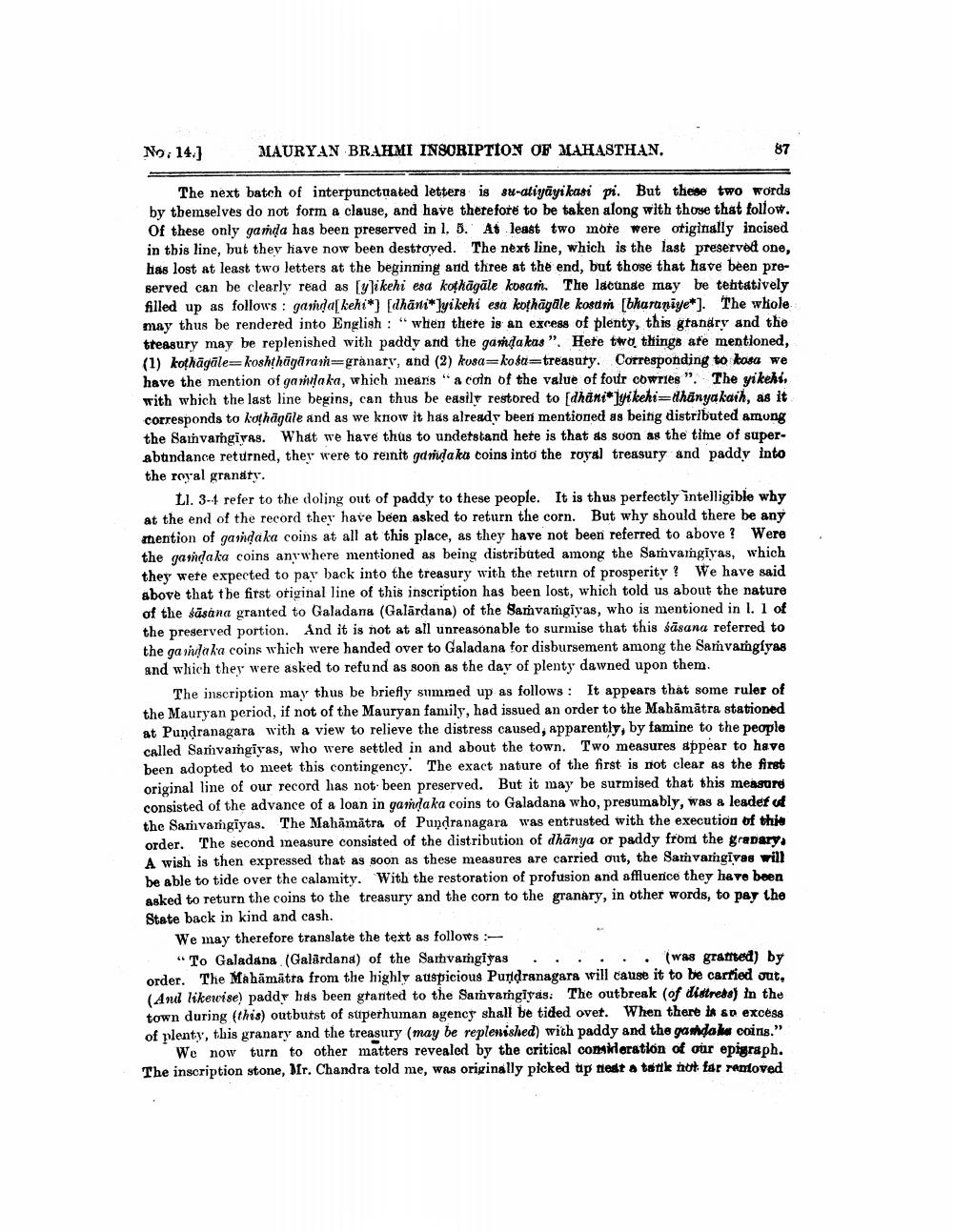________________
No: 14.]
MAURYAN BRAHMI INSORIPTION OF MAHASTHAN.
87
The next batch of interpunctuated letters is su-atiyāyikasi pi. But these two words by themselves do not form a clause, and have therefore to be taken along with those that follow. Of these only ganda has been preserved in 1. 3. At least two more were otiginally incised in this line, but they have now been desttoyed. The next line, which is the last preserved one, has lost at least two letters at the beginning and three at the end, but those that have been preserved can be clearly read as [ylikehi esa kothāgāle kusam. The lacunse may be tentatively filled up as follows: garda[kehi*] [dhāni*lyikehi esa kothāgale kosur [bharuniye*). The whole may thus be rendered into English : " when there is an excess of plenty, this gtanary and the treasury may be replenished with paddy and the gamda kas”. Hete two things are mentioned, (1) kothāgāle=koshthügirargránary, and (2) kusa=kota=treasuty. Corresponding to kosa we have the mention of gamlaka, which means "a coin of the value of four cowries". The yikehi, with which the last line begins, can thus be easily restored to [dhani*lyikehillhanya kaih, as it corresponds to kathāgüle and as we know it has already been mentioned as being distributed among the Saivargivas. What we have thus to undetstand hete is that as soon as the time of superabundance returned, they were to remit gandaka coins into the royal treasury and paddy into the royal granáty.
LI. 3-4 refer to the doling out of paddy to these people. It is thus perfectly intelligible why at the end of the record they have been asked to return the corn. But why should there be any mention of gardaka coins at all at this place, as they have not been referred to above? Were the gandaka coins anywhere mentioned as being distributed among the Samvamgiyas, which they were expected to pay back into the treasury with the return of prosperity? We have said above that the first original line of this inscription has been lost, which told us about the nature of the sāsána granted to Galadana (Galārdana) of the Samvangiyas, who is mentioned in l. 1 of the preserved portion. And it is not at all unreasonable to surmise that this sāsana referred to the gainda ha coins which were handed over to Galadana for disbursement among the Samvamgiyas and which ther were asked to refund as soon as the day of plenty dawned upon them.
The inscription may thus be briefly summed up as follows: It appears that some ruler of the Mauryan period, if not of the Mauryan family, had issued an order to the Mahāmātra stationed at Pundranagara with a view to relieve the distress caused, apparently, by famine to the people called Sanvangiyas, who were settled in and about the town. Two measures appear to have been adopted to meet this contingency. The exact nature of the first is not clear as the first original line of our record has not been preserved. But it may be surmised that this measure consisted of the advance of a loan in gamlaka coins to Galadana who, presumably, was a leader of the Sarvangiyas. The Mahāmātra of Pundranagara was entrusted with the execution of this order. The second measure consisted of the distribution of dhanya or paddy from the grapary, A wish is then expressed that as soon as these measures are carried out, the Sarvamgivas will be able to tide over the calamity. With the restoration of profusion and affluence they have been asked to return the coins to the treasury and the corn to the granary, in other words, to pay the State back in kind and cash.
We may therefore translate the text as follows:
"To Galadana (Galárdana) of the Sarvargiyas .. ... . (was gramed) by order. The Mahāmatra from the highly auspicious Pundranagara will cause it to be carried out, (And likewise) paddr has been gtanted to the Samvaṁgivas. The outbreak (of distress) in the town during (this) outburst of superhuman agency shall be tided ovet. When there is so excess of plenty, this granary and the treasury (may be replenished) with paddy and the gandaho coins."
We now turn to other matters revealed by the critical consideration of our epigraph. The inscription stone, Mr. Chandra told me, was originally picked tip niedt a tote not far rentoved




